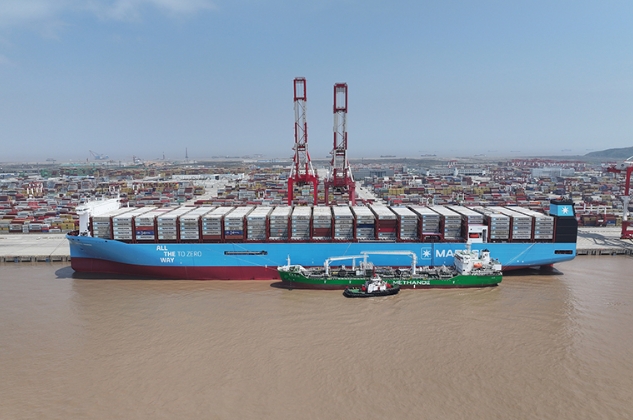Global shipping magnate stride to a greener path with Chinese hydrogen product
By Wu Siya
SHANGHAI, Apr. 11 (China Economic Net) – On April 10, the Port of Shanghai completed China's first methanol ship-to-ship bunkering operation. China's first operational methanol fuel bunkering vessel, the Haigang Zhiyuan, provided 504 tonnes of eco-friendly methanol to the Astrid Maersk, a large methanol-powered container vessel at Yangshan Port, part of the Port of Shanghai. Also, this groundbreaking operation represented the first methanol bunkering for a large container vessel in China.
"The total annual carbon dioxide emissions of the global logistics industry are 3.5 billion tons, of which the international shipping industry accounts for about 3 percent," Jens Eskelund, North Asia Chief Representative of Maersk, proposed at the Clean Energy Forum of the China International Supply Chain Expo (CISCE) held late last year, "we choose green methanol as a short- and medium-term solution to help us achieve our decarbonization goals."

Shanghai Port carries out China's first ship-to-ship methanol refueling [Photo/China Hydrogen Alliance]
Maersk are convinced that China can become the world's leading green methanol supplier with its abundant resources and unparalleled production capacity. "In November 2023, Maersk have just signed the first related purchase agreement with Chinese partners. The supply of this order could cover half of our current orders for methanol-powered ships," Eskelund emphasized.
For a long time, the shipping magnate has attached great importance to working with Chinese partners to commit to achieving the goal of net-zero greenhouse gas emissions from all businesses in 2040.
Astrid Maersk, the second of 18 large methanol-powered container ships ordered by Maersk, can sail using green methanol and traditional marine fuels. Running using green methanol can reduce carbon dioxide emissions by 280 tons per day compared with similar ships sailing using heavy oil.
Hai Gang Zhi Yuan, the world's largest methanol refueling vessel, is 135.1 meters long, 20.2 meters wide, and 11.2 meters deep, with a total volume of 16,000 cubic meters and 12 cargo holds inside. It supports synchronous methanol refueling and container loading and unloading, cutting the time needed for the turnaround of international vessels in port.
Specifically, the global shipping industry emits approximately 1.076 billion tons of carbon dioxide every year. Obviously, the use of clean fuels is the most indispensable measure for decarbonizing the whole industry, with methanol is generally considered to be one of the most promising clean fuels for ships. This achievement marks that China's technology and service capabilities in the field of green shipping have reached a new height.
"First, China has the world’s third largest waste resources and abundant scenery resources, which can be used to produce green methanol; second, the country has unparalleled engineering capabilities and rapid and efficient scale-up capabilities; third, China can produce green methanol with 100% freely available resources, thereby reducing the need for energy imports, enhancing energy independence while reducing carbon emissions, all of which is a true win-win," Jens Eskelund has no doubt about China’s huge role in the future green transformation of the global shipping industry.
(Editor: liaoyifan )


